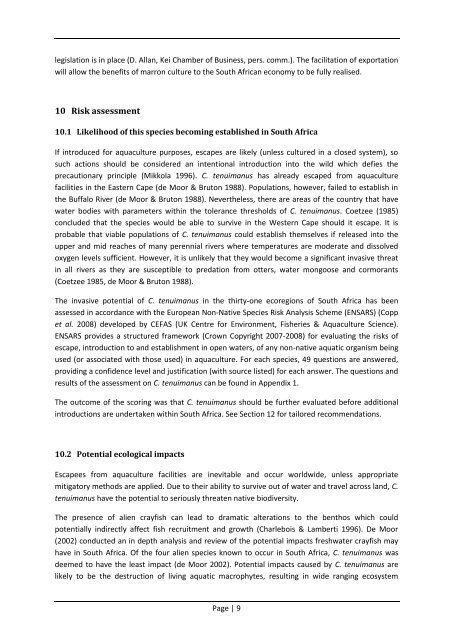Marron, freshwater crayfish Cherax tenuimanus - Department of ...
Marron, freshwater crayfish Cherax tenuimanus - Department of ...
Marron, freshwater crayfish Cherax tenuimanus - Department of ...
Create successful ePaper yourself
Turn your PDF publications into a flip-book with our unique Google optimized e-Paper software.
legislation is in place (D. Allan, Kei Chamber <strong>of</strong> Business, pers. comm.). The facilitation <strong>of</strong> exportation<br />
will allow the benefits <strong>of</strong> marron culture to the South African economy to be fully realised.<br />
10 Risk assessment<br />
10.1 Likelihood <strong>of</strong> this species becoming established in South Africa<br />
If introduced for aquaculture purposes, escapes are likely (unless cultured in a closed system), so<br />
such actions should be considered an intentional introduction into the wild which defies the<br />
precautionary principle (Mikkola 1996). C. <strong>tenuimanus</strong> has already escaped from aquaculture<br />
facilities in the Eastern Cape (de Moor & Bruton 1988). Populations, however, failed to establish in<br />
the Buffalo River (de Moor & Bruton 1988). Nevertheless, there are areas <strong>of</strong> the country that have<br />
water bodies with parameters within the tolerance thresholds <strong>of</strong> C. <strong>tenuimanus</strong>. Coetzee (1985)<br />
concluded that the species would be able to survive in the Western Cape should it escape. It is<br />
probable that viable populations <strong>of</strong> C. <strong>tenuimanus</strong> could establish themselves if released into the<br />
upper and mid reaches <strong>of</strong> many perennial rivers where temperatures are moderate and dissolved<br />
oxygen levels sufficient. However, it is unlikely that they would become a significant invasive threat<br />
in all rivers as they are susceptible to predation from otters, water mongoose and cormorants<br />
(Coetzee 1985, de Moor & Bruton 1988).<br />
The invasive potential <strong>of</strong> C. <strong>tenuimanus</strong> in the thirty-one ecoregions <strong>of</strong> South Africa has been<br />
assessed in accordance with the European Non-Native Species Risk Analysis Scheme (ENSARS) (Copp<br />
et al. 2008) developed by CEFAS (UK Centre for Environment, Fisheries & Aquaculture Science).<br />
ENSARS provides a structured framework (Crown Copyright 2007-2008) for evaluating the risks <strong>of</strong><br />
escape, introduction to and establishment in open waters, <strong>of</strong> any non-native aquatic organism being<br />
used (or associated with those used) in aquaculture. For each species, 49 questions are answered,<br />
providing a confidence level and justification (with source listed) for each answer. The questions and<br />
results <strong>of</strong> the assessment on C. <strong>tenuimanus</strong> can be found in Appendix 1.<br />
The outcome <strong>of</strong> the scoring was that C. <strong>tenuimanus</strong> should be further evaluated before additional<br />
introductions are undertaken within South Africa. See Section 12 for tailored recommendations.<br />
10.2 Potential ecological impacts<br />
Escapees from aquaculture facilities are inevitable and occur worldwide, unless appropriate<br />
mitigatory methods are applied. Due to their ability to survive out <strong>of</strong> water and travel across land, C.<br />
<strong>tenuimanus</strong> have the potential to seriously threaten native biodiversity.<br />
The presence <strong>of</strong> alien <strong>crayfish</strong> can lead to dramatic alterations to the benthos which could<br />
potentially indirectly affect fish recruitment and growth (Charlebois & Lamberti 1996). De Moor<br />
(2002) conducted an in depth analysis and review <strong>of</strong> the potential impacts <strong>freshwater</strong> <strong>crayfish</strong> may<br />
have in South Africa. Of the four alien species known to occur in South Africa, C. <strong>tenuimanus</strong> was<br />
deemed to have the least impact (de Moor 2002). Potential impacts caused by C. <strong>tenuimanus</strong> are<br />
likely to be the destruction <strong>of</strong> living aquatic macrophytes, resulting in wide ranging ecosystem<br />
Page | 9
















